Toronto International Film Festival 2017 Report Part 3: It Lies In The Film
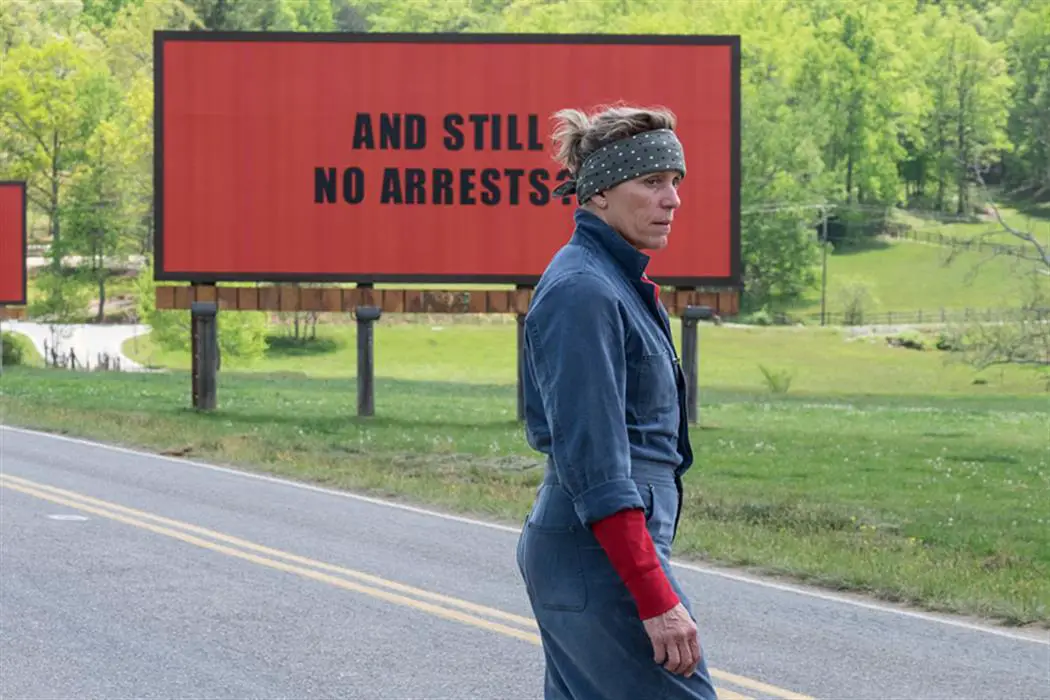
Tomas is a chronic cineaste who studied English literature in…
Day Four. Scotiabank still bursting at the seams. Long and winding lineups that spilled out onto the sidewalks, roping around the complex to the chagrin of many. Hot titles continually premiering, bringing out the public in large numbers as always. The first weekend is, by far, Toronto International Film Festival’s busiest time, and by now a peculiar thing began to reveal itself to the P&I crew: not everything was going to schedule.
As we impatiently kept checking our watches/phones, we noticed that lines were only being ushered into theaters mere minutes before the films were scheduled to begin, resulting in short delays (not a good thing if you have to run to another film right after the first one ends). If that wasn’t bad enough, volunteers had to herd lines from the streets all the way up the Escalators of Doom and across a chaotic lobby, which slowed things down even more. The volunteers always do their best, but the Scotiabank is such a cumbersome construction in its design that it must’ve been nerve-wracking as hell trying to keep all fourteen theaters functioning in an orderly manner.
Those volunteers are saints. What more can be said? Especially those working shifts at Scotiabank. The other venues may be bigger in size, but at least everyone goes into one line. You get them into the building, scan their tickets, let them take their seats. Done. Now imagine having to juggle and coordinate multiple lines for multiple films, with hoards of people asking you where to go at all times. An atmosphere rife with confusion, frustration, anxiety. Not to mention the multiple opportunities for the wily to secretly cut in line when no one is looking, or the unwitting public to block someone’s way. It’s surely more exhausting than marathoning four or five films back-to-back, and those good people have my infinite respect.
And now, to the films:
Three Billboards Outside Ebbing, Missouri (Martin McDonagh)
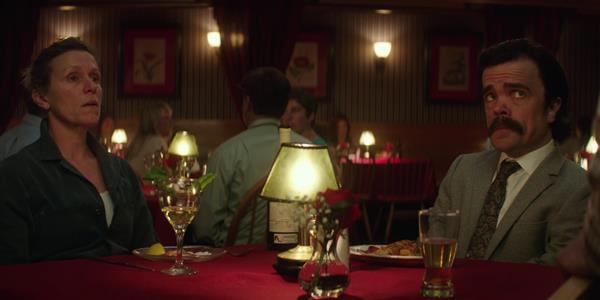
When Three Billboards outside Ebbing, Missouri opens, a character is caught reading Flannery O’Connor’s A Good Man Is Hard to Find. The moment passes in the blink of an eye, and the book is never seen again afterwards. Why is this important, you ask? Well, anyone who has read O’Connor will recognize her as one of America’s preeminent Southern Gothic writers. She memorably refined the style, charting the lives of truly despicable people while probing the extent of their moral dissolution—and whether they can be rehabilitated in the eyes of the Christian God.
Martin McDonagh both writes and does not write a modern reinterpretation of O’Connor’s oeuvre. The quick reference to her work is both a wink and a feint, meant to clue the viewer to the tonal intricacy of his work while, perhaps, planting expectations that never end up being fulfilled. What matters most is that, unlike in O’Connor’s fiction, Three Billboards exists in a nearly godless world, and McDonagh is interested in pushing his characters’ morality past the point of religion, to something much more individualistic. Whereas O’Connor pressed her caustic prose to an olive wood crucifix, palming us the transcendent, McDonagh pushes all that aside and reaches for a gun.
The title of this tale succinctly summarizes the central conflict: three abandoned billboards stand forlornly outside a fictional Missourian town, and one Mildred Hayes (Frances McDormand) buys them all out. The reason: her daughter was raped and killed on that highway, and the police still have no leads as to who did it. So, on red backgrounds and using bold black font, she shames the local sheriff (Woody Harrelson) for not doing his job properly, seeking justice when all sense of law has stagnated.
The billboards, like the eyes of T.J. Eckleburg in F. Scott Fitzgerald’s The Great Gatsby (a banal reference, I know, but one that most people at least know of) are our windows into a world that is rotting thick and fast. When Mildred puts them to use, invoking the spirit of a sense of order that has long since passed, practically no one supports her endeavor. These signs are the bloody ramifications of insult and indifference, standing guard over the site of a horrific and senseless crime. Mildred’s odyssey in the film runs on continual remembrance, because with it there is hope for restitution. Not only in finding her daughter’s killer, but also in restoring that sense of decency in her hometown that has all but vanished in the interim.
It is no coincidence, then, that McDonagh opens the film to the operatic strains of Thomas Moore’s “The Last Rose of Summer.” A melancholic poem about the process of letting go of the dead, one can see it in the context of the film as a reliquary of Mildred’s unbounded love for her dead daughter, and her continued refusal to put her spirit to rest. But it is also about eradicating loneliness: to stand with the one, final reminder of beauty in the midst of a transitory and uncertain existence. So, as soon as the film begins, we are asked to stand with Mildred—to stand even with the hope that Ebbing, Missouri can be salvaged. It is not so much that we are to envision an idyllic version of this town before the film’s narrative, but a belief that, somewhere in its pits, there is a dignity waiting to flourish again.
That I can write all this without going further than the first ten minutes is a testament to the wellspring that is McDonagh’s screenplay. It is stunningly calibrated, capable of erupting with force and then retracting to silent rumination within seconds, the shifts composed like a filmic symphony. The acting will crescendo, the mood will waft; a switch will turn, and a sudden jolt of action will collapse the comic and tragic into a nested filigree, making you applaud while your stomach churns. Quick tonal shifts can be disastrous if mishandled. McDonagh has not only mastered the method—he has turned it inside out, making the viewer truly appreciate the extended range of emotions that have been plucked like catgut.
The rest lies in the film. I could rave and rave about Frances McDormand’s effortless ability to turn hardened, unforgiving women into bona fide heroines; her Mildred Hayes is yet another stellar example of her gift, and it will be a role that will enter the pantheon of unforgettable cinematic creations in years to come, much like her Marge Gunderson. I could also summon myriads of platitudes to describe Sam Rockwell, who plays the crooked Officer Dixon. His character is given such an extraordinary arc that the film would have surely suffered without his presence. Rockwell has always been a solid character actor, and here he outdoes himself, blending a merciless brand of monstrosity with a taste of the pathetic (hint: ABBA’s “Chiquitita” in a fine needle drop) to the point where redemption seems inconceivable. And yet… and yet…
It lies in the film.
There is a good reason why almost no one hates this film so far, and why it walked away with the coveted Grolsch People’s Choice Award when the festival ended. To watch it is to recognize an inherent level of formal and tonal mastery that has finally been attained over years of practice. There is not a doubt in my mind that this was a hazardous enterprise from the very beginning. It could have sunk into the ground in the hands of an apprentice unable to firmly mold the heart and the head of this unwieldy beast. It was not him that stepped forward, however. It was the maestro.
Lean on Pete (Andrew Haigh)
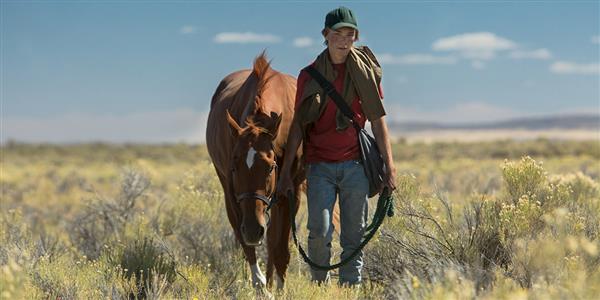
The title of this film is ironic. Shatteringly so. It’s both the name of a quarter horse given a new lease on life by a sensitive teen named Charley (Charlie Plummer, in a beautiful breakthrough performance). It is also a philosophy, dusty and cloven of the fairy tales of yore, where companionate beings could serve as guides for the major transitions in life, standing firm with the child growing to become an adolescence, then an adult. Names and philosophies, however, are no longer enough when the fairy tale is decisively unmagical—nor even a fairy tale. Magic could ward off the pangs of loneliness. Lean on Pete wants us to know that such pangs are both unavoidable and necessary.
Andrew Haigh has been a refined voice for solitary souls in cinema for the past few years. His last film, 45 Years, was all about the oncoming chill of solitude when a wife realizes that she was not the only partner in her husband’s world. That, in effect, the love they shared was second-hand. Lean on Pete is his first American-set picture, located in the dusty plains of the Oregon High Desert, where loneliness is all but manifested in dryness, juniper and sage. His protagonist is his youngest subject yet, a boy who is soon bounced from his home after a tragic incident and must set off westward in search of the only other person willing to take care of him.
This film is more about removing the talismans that bind us to untenable existences than keeping them close. Naturally, such removal begets a hollow loss that, try as we might, cannot be filled in. As Charley inches toward Wyoming on his quest for settlement, something must give before he can cross the boundary of adulthood. We dread it with all our might. We have a premonition of evil. Haigh, being the unsentimental bloke that he is, does exactly what we don’t want. Not because it is cruel, but because loneliness has always been the critical turning point.
This unsentimental streak, coupled with the unflinching way he digs into the Far West’s vistas, does remind one of Kelly Reichardt’s cinema, which is similarly probing about lives surrounded by an unforgiving physical emptiness. If it’s a tribute, it’s certainly a fine one. Haigh, however, does not linger in open spaces too much. In fact, as Charley’s quest deepens, he is suddenly confronted with a greater sense of smallness. Settings shrink. His younger, innocent self withdraws into a place of desperation, one that commits petty crimes and finds violence an unavoidable tool of existence. The path to an inward self-reliance is drawn so that, when Charley utters his memorable last words, we can see how far he has come, and also how much growing he has left to do.
The inherently tripartite structure allows the film to respire on its own terms. Haigh never lets scenes dry up prematurely, or end on false notes. The editing is graceful, and Haigh’s camera unobtrusive, letting the action rise and fall naturally without the need for superfluous styling. This will inevitably bore some. That is understandable. Not all of us have the patience to sit in prolonged serenity. With Haigh, however, there are so many elements working together in tandem that, for me, I cannot tire of it. Even if it’s just Charley speaking plangently to his horse, the mise-en-scène still spreads toweringly over the frame, inviting both the rueful and the comforting to coexist, even for just one moment.
Haigh continues to be a treasure worth seeking, and Lean on Pete is one more example of his innate sense of precision and humanity. I feared that, by turning to an American setting and a neorealist vision, he would lose that simple poeticism that made Weekend and 45 Years so perfectly haunting. I was wrong. That poeticism has not left. One can even say that it has ripened and matured, and that it will continue to do so as he moves from strength to strength.
Miracle (Egle Vertelyte)
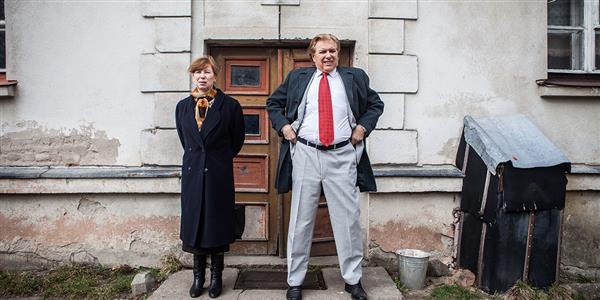
Originally I had intended to see Joe Wright’s Darkest Hour after Lean on Pete. Unsurprisingly, the lineup was massive, and again I was shut out of a buzzy screening just mere steps away from the theater doors. No matter. I had tickets for something in the evening, to a film decidedly more obscure. I chose to take my mom along for the ride, because the film ended up breaking a very long cold snap—it was the first Lithuanian film to play at Toronto International Film Festival in seventeen years. Seventeen years.
As someone of Lithuanian descent, there was no question of my missing out on the moment, and my mom felt the same way. And so, after a nice dinner sitting streetside while the din of Festival Street echoed around us, I returned to the Scotiabank with her in tow, wondering about what I was going to see. The small theatre filled quickly; when the time came, the programmer introduced the director, Egle Vertelyte, who set the stage in a lovely and comprehensive way. The film, she said, would take us back to the post-Communist interregnum of the early ‘90s, when the Baltic countries regained their independence, but not their economic stability. It was a time of serious transition towards a capitalist ideal that was hard on everyone, and the film would give us a slice of what it was like.
Miracle does just that, though perhaps more whimsically than anyone was anticipating. In 4:3 aspect ratio, with the ever-ubiquitous teal and orange grading scheme giving a colorful visual enhancement, the story follows the life of a struggling pig farmer named Irena (Eglė Mikulionytė). With the farm making little profit, and her marriage to a perpetually-drunken Juozas (Andrius Bialobžeskis) on the rocks, she is desperate for a change in her luck. Fortunately, she has not long to wait, for in blows an American blowhard named Bernardas (Vyto Ruginis), who is eager to buy her farm because the land once belonged to his parents, who fled Lithuania during the war.
Bernardas, symbolic of the capitalist world order, is not too-coincidentally a Trump lookalike, with ill-fitting suits and honeyed promises for Irena’s downtrodden employees. A scene in which he uses a “Three Little Pigs” analogy to explain the farm’s future to the workers is Vertelyte’s most pointed moment of satire, and Ruginis has a lot of fun with his hammy character, labored American accent and all.
Irena, meanwhile, looks and acts like a holdover from her country’s recent past, using a stern air and fashion as a protective shield and possessing a strong desire to stay the course at whatever the cost. Mikulionytė’s sour visage is comparable to Kati Outinen’s (the regular muse of Finnish master Aki Kaurismäki), and like Outinen, she has the talent to slowly thaw out a frosty persona by using only her capacity for expressiveness. Hence, she easily gives the best performance in the film.
The connection to Kaurismäki does not end there. The film’s tone closely resembles the hilariously monotonous affect of Kaurismäki’s oeuvre, where deadpan gags and unblinking ironies are melded in delightful combinations. For instance, there is a scene where Irena is forced to walk all the way to the back of a (very) long line at the local bank after the lone teller breaks for lunch just as it is her turn. Later, at a social dance, she is forced to bop sedately to the music all by her lonesome because her husband won’t allow her to leave the wall. Vertelyte finds a credible lightness in these minor inconveniences, and she mines them for a comic value that works.
What she is less successful with, unfortunately, is keeping the film feeling spontaneous. Too many scenes are blocked out theatrically, especially whenever the camera enters Irena’s poky, Soviet-era apartment. The set’s restrictive air is only conveyed because the camera sits still whilst the actors act out their parts and hit their predetermined cues. Another problem is that they hit their cues almost too well, lending a painstakingly rehearsed quality to these scenes. Someone topples onto a sofa too precisely; a fight scene feels tame because it is too evidently choreographed. At one point, I’m almost certain I caught an extra accidentally glancing at the camera.
All of these things could lend the film a certain charm if they stood out as the only flaws. Miracle is, after all, a debut, and one does not expect instant masterpieces from debuts. But Vertelyte also writes her quasi-allegory with a leaden hand, not taking care to leave interpreting the film to the viewer’s imagination. And so, an important set piece is bulldozed midway through, its destruction clumsily symbolic. So, too, is Bernardas’ role in Irena’s life, and what it ends up yielding. The pig farm, the trees on the property, the family treasure Bernardas seeks—everything all too evidently represents something more abstract, yet still discernable, and this makes the film slighter and less impactful.
Vertelyte also explained away the ending during the Q&A, and considering it’s the site of the most mystery in Miracle, I was rather disappointed that she did so. It was much more enlightening to hear Ruginis talk about being cast in the film, a process that involved long-distance Skype calls and honing a language he was unused to speaking regularly. There was also a moment of sadness in the discussion, as Ruginis revealed just how reluctant his parents were about relaying their past experiences in Lithuania to him. Many others in the audience could relate, having relatives who had endured far more than they could ever express. Mikulionytė also got a lot of praise for her performance, which she took with a humble gratitude.
Whether I will hear of Miracle again remains to be seen. I hope so, for it’s a nice (albeit imperfect) little film from a country whose film industry remains all but invisible to North American markets. And my mom felt the post-Soviet environment was recreated very accurately—apparently long lineups at rinky-dink banks were not an uncommon occurrence!
In the blink of an eye, it was Day Five—and, to my surprise, I was still operating on decent levels of sleep and energy (though aided by copious amounts of coffee). Perhaps my deliberate avoidance of very early screenings was a factor in that. Waking up at 7 AM for a 9 AM screening—especially after only going to sleep at around 2 AM—would’ve been too much. The key to surviving a long film festival is to prioritize sleep above everything else. Even if the 9 AM screening is a film you’ve been dying to see for months, there’s no point if, by the end of the day, you are struggling with all your might to stay awake. It’s hellishly tempting to sleep in those dark theaters, especially when films are set at nighttime or in dim rooms.
Jeannette: The Childhood of Joan of Arc (Bruno Dumont)
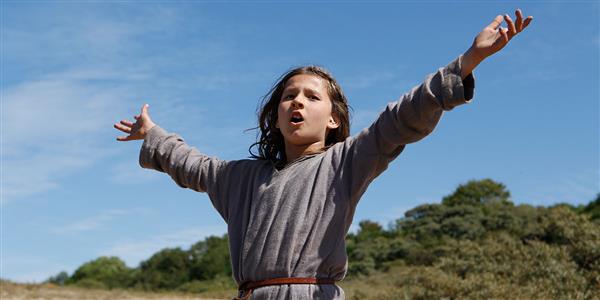
Bruno Dumont’s latest romp was given a plum screening time of 12 PM, while most others were well into the first P&I screening of Guillermo del Toro’s having reviewed and enjoyed Slack Bay earlier this year, I was in the mood for more of his peculiar brand of oddity.
Adapted from texts by French poet Charles Péguy, including his long narrative poem The Mystery of the Charity of Joan of Arc, Dumont’s film culls Péguy’s verse almost word-for-word and has it transposed to electro-pop/metal tunes by composer Igorrr. Set in 1425, in the small French village of Domremy, we are treated to the existential musings of shepherdess Jeannette (Lisa Leplat Prudhomme). Caught in a theological quandary over whether true faith in the Christian God must be followed by selfless action, she consults both her best friend Hauviette (Lucile Gauthier) and mentor Madame Gervaise (Aline and Elise Charles) about what her best course of action should be—to remain a simple peasant girl, or to rise up against the English attacking her beloved nation.
Jeannette’s retelling of the Joan of Arc mythology is unique compared to the cinematic history associated with the story (the foremost masterwork being, of course, Carl Theodor Dreyer’s The Passion of Joan of Arc). There are no outward signs of abject suffering, no grandiose and melodramatic speechifying, no dusty churches or fiery pyres. Dumont instead refocuses the mythos toward the elemental, ensuring that nearly every frame is shot outdoors, on grassy knolls populated with bleating sheep and trickling streams. This is Joan at her purest doctrinal self, enshrined in the dormancy of nature, coming to a crossroads and weighing her options. She must come to a decision, and as she sings and sings about her fervors and fears, she has to slough off the demons blocking her way.
Headbanging. Dabbing. Moshing. We go to clubs and concerts and let loose, finding music as the antidote to our pains, and establishing a kind of bodily exorcism. Dumont includes these choreographed acts anachronistically, certainly as a kind of comedic rapprochement with his audience, but also to represent the kind of ecstasy that is produced when poetry and music form a cohesive bond. The poetry for Joan is the Word of God; the music is her destiny coming out to meet it. And so, as she headbangs and moshes with greater frequency, she is subsequently freeing herself from the existential misgivings that have kept her stationary.
The film proves that Dumont’s adventurousness knows no bounds. However, this does inadvertently trip the film up in some respects. The combination of Péguy’s incredibly dense and measured verse with the slightly repetitive, fast-moving tunes requires a level of intense concentration that, after a while, becomes rather exhausting if you’re not prepared for it. With the addition of subtitles for non-French speakers, it becomes all too easy to be thrown off the game, and I’ll admit that I had to devote an inordinate amount of energy to stay in tune with Dumont’s artistic rhythm. This is no empty little trifle that one can leisurely zone out of at will: this is an intensely intellectual exercise.
I was also unsure of what to make of the film’s second half, which features an adolescent Joan now ready to embark on her Christian campaign. Maybe I was so taken by Prudhomme’s feisty showing as Jeannette that seeing Jeanne Voisin step into the role felt like a stark change in direction—as though Dumont were transitioning into an entirely new film, keeping his conceits but losing the elemental touch that made his rendering of Joan’s childhood so singular. At any rate, it felt more like a completionist move than anything, guiding us towards the inevitable conclusion of Joan’s life without necessarily needing to document it.
If the film is difficult and demanding, it also contains some wonderful treats as a counterbalance. The decision to use live sound instead of pre-recorded tracks gives an emotional rawness to Jeannette’s uncertainties. Prudhomme’s voice is resilient as hell, yet the constant belting takes a bit of a toll so that, down the road, the strain on her voice does a nice job of mirroring her strained loyalties. And the film’s biggest setpiece—a long, intricately choreographed number featuring the Charles twins playing the single role of Madame Gervaise—is incredibly executed both by the performers and Dumont himself as director. It’s the kind of number we need to see more of in modern musicals, and it was also the moment in which Dumont more than proved his worth as a capable purveyor of this genre.
Jeannette isn’t going to be seen as Dumont’s pièce de résistance. If anything, it will be seen as another successful harnessing of his unusual creative impulses. Not a bad thing, mind. Just don’t expect this to be screened at your local Sunday school anytime soon.
The Children Act (Richard Eyre)
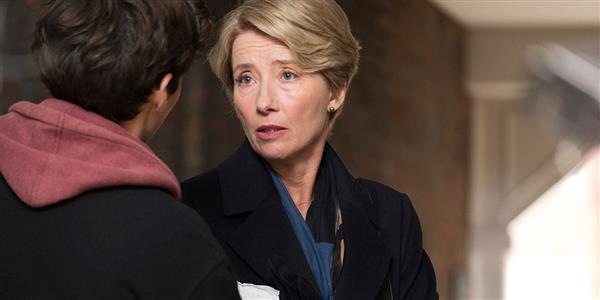
Richard Eyre is an intuitive director. He understands the stories he brings to life, the characters who inhabit him, and the ways in which they move. This is also true of The Children Act, a film he directed that is based on Ian McEwan’s 2012 novel and adapted for the screen by McEwan himself (McEwan also penned the adaptation of his novella On Chesil Beach, which I will review in my next dispatch).
McEwan is known for tackling various periods, movements and controversies in Britain’s social and political history in his books, and in this story he broaches such issues as the rights of minors in the UK, the objective duty of judges and courts, and the right to die. Fiona Maye (Emma Thompson) is a High Court Judge whose marriage suddenly implodes when her husband, Jack (Stanley Tucci), wishes to have an affair with a young statistician because he and Fiona have not made love in almost a year. Fiona scoffs at such a request, prompting Jack to pack up and leave.
Just as this happens, she is tossed an urgent case dealing with an ailing Jehovah’s Witness boy named Adam Henry (Fionn Whitehead) who requires a blood transfusion to stay alive, but refuses on religious grounds. The eponymous Children Act of 1989 stipulates that courts must promote the welfare of underage children irregardless of what is “morally” correct, though Adam’s counsel presents a compelling case, arguing that he is mature enough to make his own decision. Curious about the boy in question, Fiona takes the unusual step of visiting Adam at the hospital before delivering her verdict, and it ends up becoming a pivotal turning point in her life both personally and professionally—though she doesn’t realize it at the time.
Eyre eschews grandeur for efficiency here, preferring instead to honor the material’s gravitas. This works because it gives us a sense of the tempo in which Fiona lives from day to day. Several scenes of her walking to and from her office and apartment in Gray’s Inn Square are filmed with a sense of impatience and speed, mirroring Fiona’s own hectic schedule. Thompson’s performance also contributes to this briskness. There’s a fantastic montage toward the beginning of the film where she deals with case after case, each one working on her temper as she barks out her contempt at evident trivialities.
Thompson in general is as remarkable as she’s always been—only this time, the role is actually worth her talents. The harried air she adopts when Fiona is stressed and overworked makes her completely believable as a seasoned judge, but there is also a glowing warmth in her initial interactions with Adam that makes her down-to-earth, as well. Thompson also does a fantastic job of building Fiona’s character without the benefit of the free indirect discourse that comprises the bulk of McEwan’s novel. Unsurprisingly, the exposed psyche of the book Fiona clarifies her predicaments; still, Thompson has such a force of presence that little things can be inferred, and her development is accounted for.
What is harder to believe is the way in which the story moves from being a legal procedural to an inexplicable, one-sided romance. Whitehead does a good job of highlighting Adam’s precociousness and, later, existential itinerancy, but the film never fully prepares the viewer for this switch. Fiona’s fateful visit to the hospital ends up being the film’s key moment, yet it never feels momentous. As such, Adam’s obsessive, somewhat cosmic attraction to her is hard to swallow, and the credibility of the latter half of the film is stretched to its limits. It also doesn’t help that Adam’s character itself feels hollow compared to Fiona’s, existing not so much as a distinct entity as a walking and talking device to enable Fiona’s spiritual growth.
Nevertheless, Thompson ensures that the conclusion is a moving one. A piano recital in which she haltingly sings William Butler Yeats’ “Down by the Salley Gardens” is a bravura showcase of her emotional connection to the material, as well as a summation of the story’s sympathetic treatment of art as connective tissue and consolidator. So even though the two halves of the film don’t coalesce as they should, Thompson gracefully keeps the whole from falling apart, proving once again why she is one of the greatest treasures of the acting world.
The Rider (Chloé Zhao)
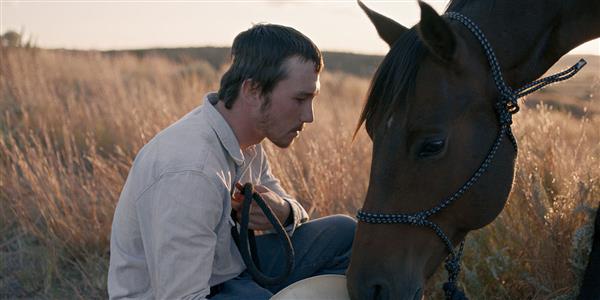
My final film of Day Five was a public screening of Chloé Zhao’s The Rider, which had screened as part of the Directors’ Fortnight at Cannes and won the Art Cinema Award there. I had not originally planned to see it, but strong word of mouth had me interested, so I snagged a last-minute ticket. I was also curious to see how Zhao would handle such inherently masculine material as cowboys and rodeos.
The buzz on this one was right on the money, for it’s truly a special achievement. A docudrama that utilizes non-actors to tell a quasi-fictionalized story of their lives, The Rider resists the machismo trappings that could have turned this into something dully conventional, instead rendering the American West and its inhabitants with an elegiac and sincere brush.
We follow the daily routine of former cowboy Brady Blackburn (Brady Jandreau), who can no longer ride bucking bulls and the like because of a serious injury that nearly cost him his life. The passion, however, is still there, and the longing to return to old glories gnaws at his insides. Yet whenever he tries to come close to those thrills, his body rebels, his hand seizing up due to a neurological delay. He is a man unwillingly trapped between two worlds, constantly desiring a destiny that threatens to destroy him.
Zhao shoots this with an extraordinary sensitivity, allowing her actors—particularly Brady Jandreau—to fill the screen with their presences, while also taking care to showcase the beauty of their surroundings. Jandreau’s performance is quietly marvellous, acutely sad at times, natural and magnetic at others. For someone who has never acted before, he more than acquits himself with the challenges, this most evident in the horse-breaking scenes.
Jandreau trains horses for a living, but onscreen the practice becomes something akin to a religious experience. The way Jandreau becomes attuned to the horses, slowly earning their trust, while also letting his invisible disability hang silently in the air, results in some utterly stunning moments of elemental honesty. Nature in harmony with man. Man desperately clinging to that harmony, despite knowing deep within himself that he can no longer reach the ecstatic unity that once gave his life purpose. It’s a privilege to witness, and one of the best sequences I saw at this year’s festival.
Zhao and Jandreau were on hand after the screening for a short Q&A, where Jandreau assured the audience that his recovery was going well. In answer to another question, he admitted that acting for the camera took a while to get used to, but was ultimately fulfilling for him—so much so that he is ready to act again. He also updated us on the condition of his friend Lane Scott, another cowboy who suffered a near-fatal accident that proved to be far more serious than Brady’s. In the film, the semi-fictionalized Brady visits him in the hospital on a few occasions, and we see Lane barely mobile and unable to speak. Fortunately, he has come a long way since the film was shot, and we were told he had even made an appearance at Telluride, where he even said a few words to the audience.
As for Zhao, she admitted that she had no prior experience with the material, even admitting that the rodeo world held little interest before she began making the film. It was when she met and got to know Brady, however, that her opinion began to change. Now I’m sure she has no regrets. Her case also proves that sometimes the most successful art comes from places we would never think of looking at twice. When we let go of our prejudices and embrace the unknown, what follows has the potential to excite and amaze. The Rider is a case in point.
Toronto International Film Festival
In my next dispatch, I’ll be looking closely at the People’s Choice first runner-up I, Tonya, as well as detailing the latest offerings from esteemed filmmakers Robin Campillo, Guillermo del Toro and Hong Sang-soo. Stay tuned!
What’s your favorite docudrama (i.e. a film that combines real and fictional elements)? Let us know in the comments below!
The Toronto International Film Festival ran from September 7th to the 17th.
Does content like this matter to you?
Become a Member and support film journalism. Unlock access to all of Film Inquiry`s great articles. Join a community of like-minded readers who are passionate about cinema - get access to our private members Network, give back to independent filmmakers, and more.
Tomas is a chronic cineaste who studied English literature in university (in both the undergraduate and graduate levels), and hopes to pursue a career in writing. His passion for film began in earnest at the beginning of the 2010s, and since then he's been reveling at the vast horizons of the cinematic landscape like a kid at the proverbial candy store.













